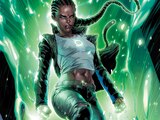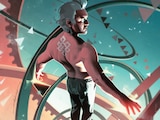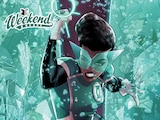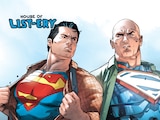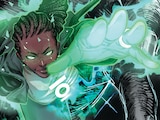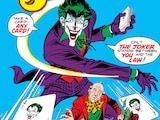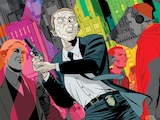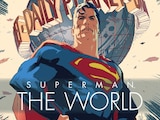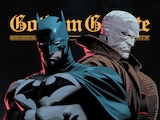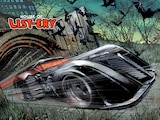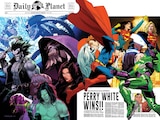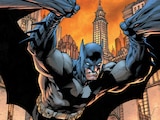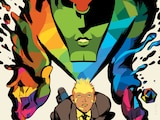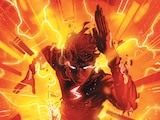1989’s Batman is more than just a cult classic. The blockbuster was a landmark in the long history of the Dark Knight, ushering in a new era for the hero with a bigger-than-ever audience who had never seen Batman embrace the shadows. Its sequel, Batman Returns, hit silver screens a few years later, but left some questions from the first film unanswered in the decades that have since followed.
Until now.
Renowned author John Jackson Miller fills in some of those blanks in his highly anticipated new novel Batman: Resurrection. What was Gotham City like after the Joker’s reign of terror? How do its citizens feel about their new resident superhero? And whatever happened to Vicki Vale?
You can get a few hints to the answers to those questions and more right now, thanks to Miller, who was happy to chat with us about the World’s Greatest Detective, what it was like to see Batman on the big screen in 1989, the unique challenges that come with writing Batman in prose and much more.

Photo © Meredith Miller
Do you remember seeing Batman ’89 for the first time?
Absolutely. I was a journalism student at the University of Tennessee at Knoxville, managing the student newspaper The Daily Beacon—and as there wasn’t much going on during the summer session, I had started assigning myself movie reviews. I showed up for the Thursday night preview showing hours early to get my ticket—and as the hour neared, I increasingly saw people showing up in Batman or Joker costumes. This was long before the practice was common—it was clear something special was going on. The place crackled with energy.
Batman had what I strongly believe was the most successful movie advertising campaign of all time, but this went beyond the hype. It was hope for a screen version of the character that would be more serious than we’d gotten in the past, more like what we saw in the comics. When the opening music started, the applause and cheering erupted—and it would be even louder at the end. My newspaper review said the film had done something far beyond simple entertainment: it redeemed comics in the popular culture.
I’d go on to see it a dozen times in the theater!
What makes Batman ’89 stand apart from other versions of the Dark Knight?
Obviously, there was the tonal difference from the TV version, which a lot of people born after 1966 weren’t fans of at the time, myself included. That’s changed over the years as I’ve grown to understand more about the context of television and comics in the 1960s, but in the late 1980s, comics readers were hungry for a Batman that more reflected what they were seeing on the printed page. That meant a darker, more violent Gotham City, with a brooding, capable Batman engaging in credible-looking combat with villains who were more macabre than cartoonish.
The post-Burton films in the 1990s strayed from that model, adding less realistic elements. And the tonal difference was such that many viewers consider Batman and Batman Returns a separate, coherent world, even though several of the supporting actors recur.
The later versions are more serious, for sure, although you can still easily tell a Burton film from, say, a Christopher Nolan one. While far more rooted in reality than what came before on screen, Burton’s films have kind of an insular, storybook world feel to them that are common to all his movies. Anton Furst’s Gotham City is kind of a snow globe wherein a very small number of exceptional people collide with one another. Titans over everyone else, and all still broken in some way.
The late Gene Siskel wrote that Batman Returns was “an opera about loneliness,” and that phrase has resounded with me ever since in thinking about Burton’s films.

When does this story take place?
We aren’t specific, but it’s several months after the events at the Joker’s parade. This was a deliberate decision on my part, because there’s three years (or more) in between Batman and Batman Returns. As I have already found in my work in a galaxy far, far away, you can put a LOT of stories into a period that size. This is one of them.
By setting the work in between the two movies, we’re able to be distinct from what Sam Hamm and Joe Quinones are doing in the Batman ’89 comics. Those are set well after the second film.
What’s the state of Gotham City after the Joker’s defeat?
It’s still adjusting to the New Abnormal. The Joker has left deep scars on the city. The Smylex poisonings impacted a lot of people before Batman discovered the mechanism. Bruce Wayne has been working with the city—and one very gifted doctor in particular—to try to help people recover, and that’s a case where Bruce can act where Batman can’t. Michael Keaton’s Bruce is shown less as a playboy and more of an active, helpful member of society. He’s looking for places where he can play a role when he’s not in costume.
It's a very different period on the Gotham City side of things: Commissioner Gordon and Harvey Dent are adjusting to working with a costumed vigilante. How does that relationship work, exactly, and what are the difficulties they encounter?
And then there’s Gotham City’s business sector, including Max Shreck. We know from the Penguin he had a lot of corrupt dealings: what’s his take on what happened to Gotham City’s underworld under the Joker and afterward? How does Batman’s existence change his many plans?
Whether you’re a millionaire or a doctor, a reporter or a street crook, Batman’s existence means Gotham City will never be the same. We worked to really convey that feeling.

We never really learned what happened to Vicki Vale. How would you describe Bruce's relationship with her in the book?
Vicki at the end of the first film seems adjusted to the idea that he’s continuing to be Batman even after the Joker’s defeat—but we also know that her opinion changed. We delve into some of that. At the opening, she’s away on assignment—but we learn fairly soon that it was more than just opportunity that drove her away.
And this is something the book really gets into. Alfred has had a lot more time to become adjusted to Bruce’s activities, but even he has concerns—the same ones that caused him to invite Vicki into the Batcave in the first place. I think by the book’s end, we have a clear picture of how all these relationships work and how they’ve changed.
Prose is a fun chance to get inside Batman’s head. How did you approach writing his voice? Is it different from Bruce Wayne’s?
Bruce is a thinker working on multiple levels at once. In Keaton’s portrayal, that comes across sometimes as being preoccupied and distracted, and I tried to include a number of those moments. Another dynamic is he’s really not getting enough sleep—at least in this story!—and so he’s constantly having to summon the determination to keep at whatever he’s doing.
As Batman, he tends to be strictly about the business of whatever he’s doing. He needs that, to stay alive. But—and this is common to my work in other franchises—I also wanted to really engage with the logistics of what he does. One doesn’t just have multiple special vehicles without a lot of preparation, and a constant problem is that he’s not near either his costume or the Batmobile when trouble arises. The sprawling size of Gotham City is something he has to grapple with all the time.

A few Batman ’89 characters make a return in this novel. Who was the most fun to write?
Bruce and Alfred have a wonderful dynamic, which is all there on the screen. Keaton and Michael Gough were terrific together. Alfred’s splitting his time between keeping Batman effective while also making sure Bruce doesn’t starve himself to death. The repartee between them is a highlight of the novel, and my editor Tom Hoeler and I really enjoyed those sections a lot.
And given my journalistic beginnings, I really enjoyed bringing back Alexander Knox and all the wisecracks he brings. We get to see how his job has changed as well. I also really enjoyed writing the new major players the book introduces.
If you could pick one of Batman’s Utility Gadgets to have for your own, which one would you want?
Having just attended DragonCon with its famously long lines and colossal hotel atriums, I sometimes thought having a grapple launcher would have gotten me out of the crowd. But I don’t like heights nearly as much as Batman does!
Batman: Resurrection by John Jackson Miller hits bookstore shelves on October 15, 2024.

